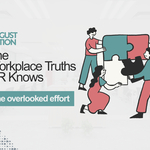
Dreaming Big, Building Belonging
August 30, 2025




Workplaces run on more than tasks and targets. They run on the quiet energy of people holding space for each other. The patience to listen when tension rises. The smile that steadies a tough day. The extra effort to keep teams connected. We call it emotional labour; and the truth is, most workplaces treat it as invisible.
Defining Emotional Labour at Work
When I talk about emotional labour, I do not mean smiling through meetings or being the “nice” one in the room. I mean the real effort it takes to carry people through the hard parts of work. The late-night call to calm a worried colleague. The quiet check-in after a heated discussion. The way someone keeps a team from falling apart when pressure is at its peak. None of this appears on a job description, yet it is what holds culture together every single day.
Breaking the Gender Stereotype
Too often, emotional labour gets framed as “women’s work.” As if remembering birthdays, checking in on wellbeing, or smoothing tensions is something only one gender should carry. The truth is, everyone does it. Some of the most emotionally supportive people I have worked with were men who never got credit for it. When we limit emotional labour to gender, we miss the point. This is not about who you are. It is about the extra, invisible weight that workplaces quietly pile on certain shoulders.
Why It’s a Workplace Blindspot
The problem with emotional labour is simple. We all see it, but we rarely name it. It does not get written into job titles. It does not show up in KPIs. Yet it is there—in the way a team stays calm during change, in how conflicts cool down, in how new joiners settle in. Leaders often say they value culture, but they forget that culture survives because someone is putting in this invisible work. And when that work goes unnoticed, it turns into a blindspot that costs more than we realise.
The Cost of Ignoring It
When emotional labour is left unrecognised, it drains the very people who carry it. They give, they support, they hold the team together—until one day they are too tired to keep going. That is how burnout creeps in. Teams start to lose energy. Engagement fades. The culture feels heavy, even if the work is getting done. And the irony is, by the time leaders notice it, the damage is already showing up in turnover, silence in meetings, or a lack of trust across the floor.
A Better Way Forward
The first step is to admit that emotional labour is real work. Once we see it, we can start to share it. It cannot sit on the shoulders of a few people while everyone else looks away. Teams can be taught how to listen, how to support, and how to stand by each other. Recognition matters too. A culture grows stronger when we pause to notice the people holding it together. At Inspire, this is the kind of space we build. A workplace where the invisible is finally seen and valued.
In Closing
Emotional labour is the glue that holds workplaces together. But when the same people keep carrying it, that glue cracks. If we want teams that feel alive, we need to call it out, share it, and give it the respect it deserves. This is where culture really shifts.
At Inspire, this is the work we stand for. If you are ready to see how engagement can change the game for your people, let’s have that conversation.At Inspire, this is the work we stand for. If you are ready to see how engagement can change the game for your people, let’s have that conversation .